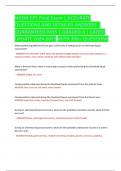NASM CPT Final Exam | ACCURATE
QUESTIONS AND DETAILED ANSWERS |
GUARANTEED PASS | GRADED A | LATEST
UPDATE 2024-2025 WITH 300+ QUESTIONS
What positional guidelines do you give a client who is setting up for an Overhead Squat
assessment?
- ANSWER Feet shoulder-width apart and pointed straight ahead; foot and ankle complex in a
neutral position; arms raised overhead, with elbows fully extended
What is the level that a client is instructed to squat to when performing the Overhead Squat
assessment?
- ANSWER Height of a chair
Compensations observed during the Overhead Squat assessment from the anterior view. -
ANSWER Feet turn out and knees move inward
Compensations observed during the Overhead Squat assessment from the lateral view. -
ANSWER Low back arches, excessive forward lean, arms fall forward
During an Overhead Squat assessment, what are the probable overactive muscles when the feet
turn out?
- ANSWER Soleus, lateral gastrocnemius, and biceps femoris (short head)
During an Overhead Squat assessment, what are the probable underactive muscles if a client's
feet turn out?
- ANSWER Medial gastrocnemius, medial hamstring complex, gracilis, sartorius, popliteus
,During an Overhead Squat assessment, what are the probable overactive muscles when the
knees move inward?
- ANSWER Adductor complex, biceps femoris (short head), tensor fascia latae, vastus lateralis
What are the probable underactive muscles when a client's knees move inward during an
Overhead Squat Assessment?
- ANSWER Gluteus medius/maximus, vastus medialis oblique
During an Overhead Squat assessment, what are the probable overactive muscles when there is
an excessive forward lean?
- ANSWER Soleus, gastrocnemius, hip flexor complex, abdominal complex
During an Overhead Squat assessment, what are the probable underactive muscles when a
client shows an excessive forward lean?
- ANSWER Anterior tibialis, gluteus maximus, erector spinae
During an Overhead Squat assessment, what are the probable overactive muscles when the low
back arches?
- ANSWER Hip flexor complex, erector spinae, latissimus dorsi
During an Overhead Squat assessment, what are the probable underactive muscles when a
client's low back arches
- ANSWER Gluteus maximus, hamstring complex, intrinsic core stabilizers
During an Overhead Squat assessment, what are the probable overactive muscles when the
client's arms fall forward?
- ANSWER Latissimus dorsi, teres major, pectoralis major/minor
What are the probable underactive muscles when a client's arms fall forward during an
Overhead Squat Assessment
,- ANSWER Middle/lower trapezius, rhomboids, rotator cuff
After assessing a client's Overhead Squat, which muscles should you have them foam roll and
stretch?
ANSWER Overactive muscles
After assessing a client's Overhead Squat, which muscles should you have them strengthen? -
ANSWER Underactive muscles
Name movement compensations observed during a Pushing assessment.
ANSWER Low back arches, shoulder elevates, head migrates forward
During a Pushing assessment, what are the probable overactive muscles when a client's lower
back arches?
- ANSWER Hip flexors and erector spinae
During a Pushing assessment, what are the probable underactive muscles when a client's lower
back arches
- ANSWER Intrinsic core stabilizers
During a Pushing assessment, what are the probable overactive muscles when a client's
shoulder elevates/head migrates forward
- ANSWER Upper trapezius, sternocleidomastoid, and levator scapulae
During a Pushing assessment, what are the probable underactive muscles when a client's
shoulders elevate?
- ANSWER Middle/ lower trapezius
, During a Pushing assessment, what are the probable underactive muscles when a client's head
protrudes forward?
- ANSWER Deep cervical flexors
Name the assessment that measures lower extremity agility and neuromuscular control. -
ANSWER Shark Skill Test
What is an indicator that a female client's ankle complex will be in a plantar flexed position for
extended periods of time based on occupation?
- ANSWER Wearing dress shoes (high heels)
Name the class of medication that decreases heart rate and blood pressure
- ANSWER Beta-blockers
Name 2 conditions in which Beta-blockers might be prescribed
- ANSWER High blood pressure and arrhythmias
When is the best time for clients to measure their resting heart rate?
- ANSWER upon waking in the morning
Name two common tests for assessing cardiorespiratory efficiency.
- ANSWER YMCA 3-Min Step Test & Rockport Walk Test
What are three methods of assessing body fat percentage?
ANSWER Underwater weighing, bioelectrical impedance, and skin fold measurements
What is the BMI range for a person who has a very high risk of disease?
- ANSWER 35.0-39.99




